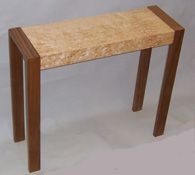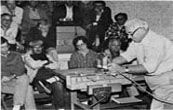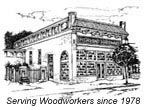|
||||||||
|
|
||||||||
|
|
|
|||
|
Jim Dillon Interviews Roger Cash
Like me, and a list of other furniture builders I could rattle off, Roger Cash started an academic career in the humanities (philosophy, in his case) before becoming a professional woodworker.

Jim Dillon: How, why, and when did you decide to make the transition from academia to self-employment as a craftsman? Roger Cash: Wittgenstein was always urging his pupils to leave philosophy and become carpenters, and I'd like to pretend that I'd heeded that call. In fact, it was more that I'd turned thirty without a proper job, and I needed to earn my living. But I had a certain reluctance to embark on a long period of professional training and more examinations - the crafts are one of the few areas left to us where acceptance depends on results rather than paper qualifications. Fortunately I had some familiarity since childhood with the tools and techniques of woodworking (metal, clay and other stuff remain alien and mysterious to me), and that determined my choice. When I started making furniture, I didn't really know that there were other makers around, indeed a whole live tradition: I really believed that I'd invented it for myself. It took me a whole year to discover that any kind of training was available. JD: Here in the states, formal training in woodworking, by which I mean college-level programs leading to degrees, are few and far between. Most custom furniture builders come to the craft through other trades, and learn through a combination of informal, brief apprenticeships; short-term classes; and lots of solitary practice. I know you went through a formal course of study at a nearby college; would you say most professional woodworkers in the UK get some sort of formal training before hanging out their shingle? RC: I was extraordinarily lucky, eighteen years ago, to discover Rycotewood College in Thame, Oxfordshire, virtually on my doorstep and running one of perhaps three or four furniture design and making courses in England at that time. Now, there are may be a hundred degree-level courses in the country. Unfortunately, the emphasis is increasingly on "design" at the expense of a good foundation in practical skills: the interests of teachers (who find design projects easier to assess than practical skills), institutions (who find it cheaper to provide computer terminals than workshops) and students (who believe that they will be paid better as designers than as makers) conspire to produce a generation of over-qualified incompetents. Unfortunately, you can't design furniture unless you know - from practical experience - how to make it. 
JD: Do you find that a first-time client is very well-informed about the world of custom furniture? For instance, might a typical client approach you with an idea they got from seeing the work of John Makepeace, Robert Ingham, or perhaps an Arts and Crafts figure like Sidney Barnsley? Or is it usually more along the lines of "I'd like a bookcase in reddish wood that will fit into this space?" RC: Yes, I've made a lot of bookcases like that! There are certainly many clients who seek out makers because they have a practical requirement which can't be met by any commercially available furniture. However, I think it's fair to say that the majority of my clients now come to me because they despair of the quality of commercial furniture, or because they simply like the idea of having things individually designed and made for them. They're often aware of the designer-maker tradition, but not so often aware of other contemporary makers (except big names like Makepeace or Linley, whom they generally regard as beyond their pockets). Very few clients in the UK see contemporary furniture as collectable, or as investment material: most simply want good things to use and pass on to future generations. JD: On your webpage you mention CAD. Which CAD software do you use? Do you find it most useful at the stage of presenting a design concept to a client, as part of a contract laying out exactly what work you'll be doing, or during the building process? For example, while I might use CAD all through a project, I'm most grateful for it when I need an accurate full-sized drawing in the shop for laying out joinery or even constructing jigs. RC: I use Turbocad, because I can't afford Autocad and I'm too honest to use a pirated version. Yes, really. All my clients get a dimensioned technical drawing as part of the contract between us; but I often find it useful to omit details which may change in the course of making! Very few clients can accurately interpret technical drawings, so the presentation of a design is more usually through rendered sketches, mock-ups and samples of material. Scale models are great - the clients love them, understand them, and they don't necessarily take long to make. My own design work still relies on unintelligible scribbles, usually on the back of old bar bills and Royal Ballet programmes which I save for the purpose. I also mess about with offcuts a lot. Like you, I find the computer a real help in construction: where I would once have laid out a full-sized story stick, I'll now often use a CAD drawing for curves or angles.
JD: Who or what are your major design influences? RC: Alban Berg, Arvo Pärt, John Coltrane, Michael Nyman, Radiohead…oh, sorry, you wanted me to mention furniture designers? I think it's a mistake to suppose that each of the arts and crafts develops separately in its own little cell; one could scarcely claim to be a designer without an awareness of the general culture, from poetry to cookery. But to keep within our own box…all British designer-makers are deeply influenced by the Arts and Crafts movement - it's the tradition in which we're trained, with its weird insistence on the value of hand-work for its own sake, honesty in construction and truth to materials. For most of us the question is still - how do we situate ourselves with respect to that tradition? Edward Barnsley's classicism gives one answer, which I'd be prepared to count as an "influence." Further afield, the Wiener Werkstätte and French Art Deco designers such as Emile Ruhlmann seem to me to bring furniture design back to where it belongs, as an urban and urbane activity rather than a quaint rural survival. In our own time, Alan Peters is most important to me; and among contemporaries I should mention Rupert Williamson (by whom I had the good fortune to be taught): his confident technical mastery means that even the most flamboyant designs retain an integrity which never goes over into mere show. JD: Any manifesto of your own you'd care to insert here? RC: That's a very tempting, open-ended offer! But if I were to confine myself to one theme it would be this: I take pleasure in making furniture for use, not for show. I want to make things that interact substantively with their owners. This comes from my belief that people are morally improved by a constructed environment in which utility and beauty are combined. And that leads me to two thoughts. Firstly, as a designer it's not my role to express or intrude my personality. I am (as you know) witty, lovable and charmingly eccentric - but my clients don't need to be reminded of that each time they sit down at their dining table. Secondly, I have a deep distrust of studio furniture: pieces designed just for show, in abstraction from real constraints of practicality or budget. Fortunately, I have so many clients demanding useful pieces that I don't have time to make stuff to gather dust in galleries. For more information about Roger Cash and his work visit his website: www.rogercash.co.uk |
|||
|





